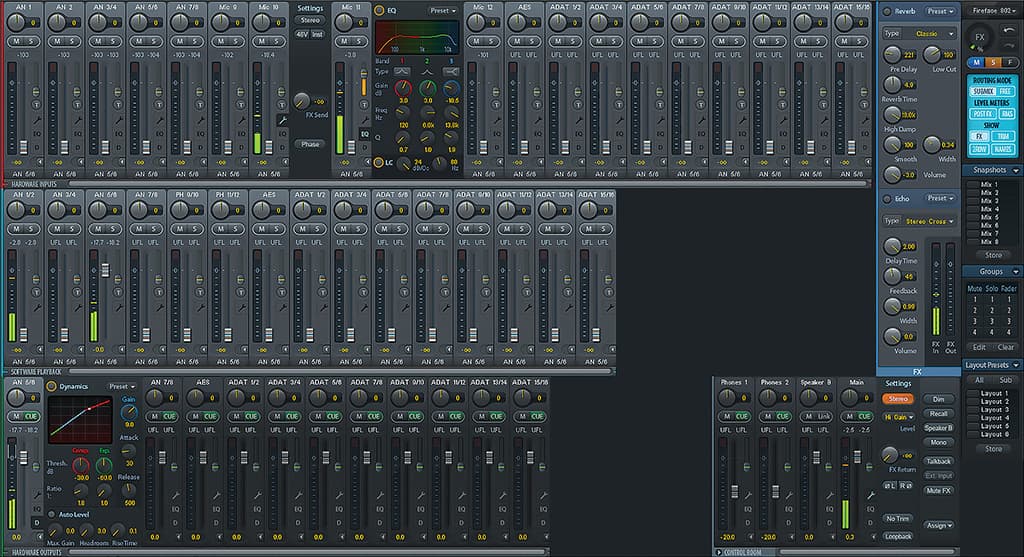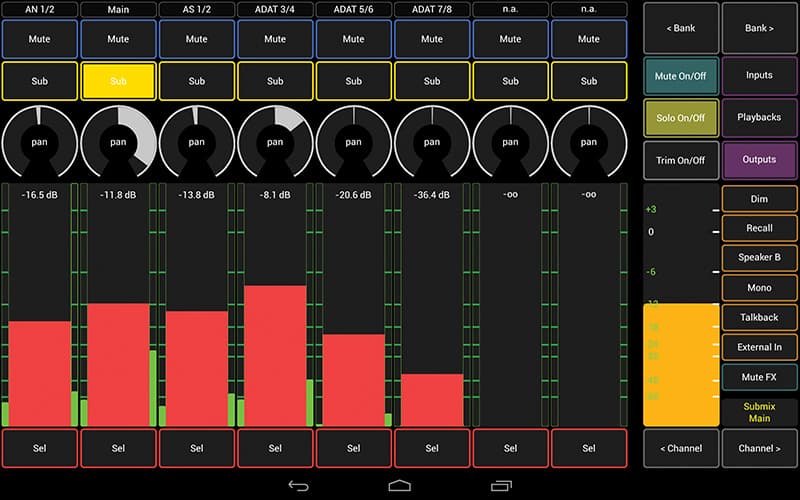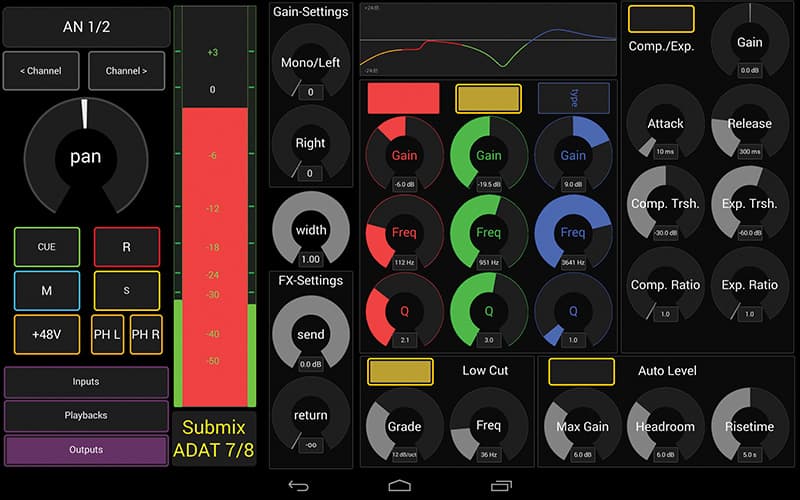
Review: RME Fireface 802 Audio Interface
With this shiny new update to a modern classic RME has taken a few steps back to move forward.
While hardware updates are commonplace for some audio manufacturers, RME has traditionally elected to keep moving forward, maintaining a fully-supported line of legacy devices for every possible requirement. While there’s no question it’s worked, it has produced a catalogue capable of confounding prospective customers with small feature variations and sometimes elusive component and design iterations. With the Fireface 802, RME is not trying to reinvent the wheel; just improve it a little.
NO SOUND IS GOOD SOUND
RME’s official company line is that its products aim to have no sound; capturing sources with a neutral accuracy that maintains integrity rather than imparting flavour. While it’s clear from all the public product statements that the Fireface 802 incorporates significant technical improvements over the preceding Fireface 800, and therefore sounds better (and it does!), any RME forum discussion regarding differences between current models, like the UFX, UCX, Babyface or 802, will be met swiftly with official comment discouraging circuit design chit or chipset chat and promoting a pragmatic and sensible focus on feature set and application.
To this end the Fireface 802 is simply best understood as the new Fireface 800, with an extra headphone output, AES/EBU I/O, USB 2.0 interface and Firewire 400 rather than 800; although a 1394b connector is still provided for convenience. Even this curious change, considering the name, is explained away as the removal of an interface no longer required for performance, due to the capabilities of the USB option, and inefficient from a cost standpoint. Four combo instrument/preamp channels owe their design heritage to the OctaMic II while the latest low latency A/D D/A converters operate at sample rates up to 192k, achieving 118dBA dynamic range on playback and 116dBA signal-to-noise ratio on the way in. The rest is as you’d expect from a Fireface. Dual ADAT I/O; supporting S/MUX2, S/MUX4 and SPDIF; word clock I/O; MIDI I/O; SteadyClock; stand-alone operation; and support for RME’s Advanced Remote Control (ARC). The most notable difference comes on the outside with the slick new aluminium face and chassis. The trademark RME blue remains, although more sparingly applied, while simple black pots cap off the restrained elegance of the redesign — and feel great too. All of the TRS jacks and pots are board mounted which irks me every time, but I’ve been using RME for years and never had a problem. I noted one forum post bemoaning the less than perfect alignment of the knob indicator lines and this was indeed the case with one channel in particular on the test unit.
INTERFACE VALUE
Much of the flexibility of current generation Firefaces comes from the TotalMix FX DSP mixer/matrix. I’ve covered TotalMix FX in some detail previously, on the release of the Babyface (Issue 78) and Fireface UFX (Issue 80), so I’ll try not to dwell too long here in description. TotalMix allows for the creation of as many different mixes of input sources and software outputs as you have available hardware outputs. In the case of the Fireface 802 this would be a maximum of 15 possible stereo cue mixes at 48k sample rate (with all digital outputs assigned). This is complemented by a patching matrix supporting signal splitting, bussing and configuration as an ADAT converter, and a detailed master section with tailored features like talkback, dim, mono, preset level recall, external input monitor, A/B speaker switching, mute/solo/fader groups, and mixer layouts and snapshots. TotalMix even makes it possible to loopback one output of your DAW into another input, or to interconnect different audio applications. Without too much trouble I was able to patch a recorded audio track from Sonar X3 out through TotalMix into AudioMulch for some granular processing, and then back into Sonar without the need for ReWire support or any third-party tools or cabling.
NEED TO KNOW

Up until a few weeks ago the inclusion of TotalMix FX with the 802 would have been a source of great envy for current Fireface 800 users, who were constrained to using the Hammerfall/Fireface mixer. But thanks to RME’s TotalMix FX-4-All update, all devices released after 2001 now employ the current user interface and many of the new features. You’ll still need the DSP power available in the UFX and 802 to enjoy per-channel three-band parametric EQ, HPF, Compressor/Expander and Auto Level, along with an auxiliary Reverb/Echo channel. In tests the 802 managed 36 mono channels of activated EQ, HPF and compression when running at 48k, while this processing capacity was reduced by approximately 50% each time the sample rate was doubled. For those recording regularly at 96k, TotalMix should have enough DSP power to handle most applications but it might have been nice to include a little more processing headroom as future-proofing. Effects can be recorded via a global switch in the driver dialog but they’re included primarily for the creation of monitor mixes and serve this purpose well. Using TotalMix to monitor live inputs also ensures the lowest possible monitoring latency, regardless of changes to the buffer size (0.69ms@48k, 0.32ms@96k). It’s worth noting that this is the best performance I’ve yet recorded and as close to zero latency monitoring as you could hope for.
To harness this mix potential, TotalMix supports both MIDI and OSC for external control, while iPad owners can use the TotalMix FX App. Curiously RME is still to implement OSC support within this app and I would consider both this and a full port to Android as a valuable development moving forward. As it happens I had no problem configuring the Android app OSC Commander for the task, thanks to its included TotalMix profile. With TotalMix supporting up to four external OSC devices you could easily opt for a cheap Android tablet solution to your headphone mixing needs and forget that Aviom system altogether. With the Fireface 802 lacking front panel controls for TotalMix these mobile solutions become even more valuable. RME’s ARC can provide rapid access to a large number of important controls via its large master jog wheel and programmable function buttons but the $299 price tag and 5m cable may be a significant turn-off for some in comparison with a mobile wireless device they already own.




iPad owners can tap into the RME-built Totalmix FX app to control the software from their tablet. Andriod users aren’t completely left out in the dark though. Totalmix FX profiles come with OSC Commander’s Android app. A great option for controlling Totalmix FX away from your desktop.
THE DRIVING FORCE
The increased prevalence of ‘zero-latency’ monitoring options has served as a valuable form of misdirection for interface manufacturers. With many achieving round trip latencies in the vicinity of 2ms (at 48k) the imperative to really stress systems with lower buffer settings has been minimised. However, anyone playing live or relying on software instruments will still need to pay close attention to real world latency stats. In these situations, stable operation with low buffers remains a priority. This has always been a strength of RME devices and the Fireface 802 is able to capitalise on over a decade of development in this area. Numbers will vary here, based on your OS and choice of either Firewire or USB. See the table (over page) extract for a sample of some measured round trip latency values.
The improvement in results from the original is clear with the 802’s USB implementation significantly reducing latency in comparison to its predecessor on OSX. In my opinion, anything below 8ms is a desirable result although in certain circumstances people will tolerate a monitoring delay of up to 12ms. While latency figures can help in assessing the quality of an interface they need to be evaluated in concert with audio stability at the same settings. As processing loads increase so does the risk of dropouts and glitches. This risk becomes even greater at the lowest buffer settings with performance steeply falling away (between 32-96 samples depending on the device and sample rate). Not only did the Fireface 802 perform well in a range of stability tests — consistently second only to my RME PCI interface — but its low latency values meant that often buffers could be increased without significantly compromising the monitoring experience. Best performance was achieved on both Windows and OSX using a USB 2.0 connection. While the 802 features only a Firewire 400 implementation I still found the compatibility of mainboard chipsets had a significant bearing on performance. On Windows, a Texas Instruments-equipped Firewire 800 PCI card delivered performance consistently matching and sometime beating the USB 2.0 ,while an Apple Thunderbolt-to-Firewire adapter provided solid performance only just off the USB pace. By contrast, the onboard Windows FW 400 connection was less stable while an early generation onboard NEC USB 3.0 controller performed well at most buffer settings but fell away more steeply at the lowest.

RELIABLE PATH
When you combine rock-solid driver performance with unique features like driver-based varispeed controls — great for pitching tracks to wonky old instruments — and the type of ongoing company support that continues to deliver significant driver and software updates more than 12 years after some customers have spent their last dollar, you’ve got a product you can feel comfortable investing that little bit more in.
I’ve recently been testing a number of audio interfaces in the hope of developing a clearer picture of performance across a range of installations and applications. As part of these experiments, blind comparisons were made between the ADC, DAC and preamp/DI channels of the Fireface 802 and the UA Apollo using a series of split recordings and listening tests. A number of participants were involved in a few different studio spaces. Differences were noted fairly consistently between listeners, however, in all cases, even when a preference was expressed, the sonic variations were deemed insufficient to conclusively determine a product choice without further evaluation of feature set and driver performance. While Apollo has the run on tracking with ‘vintage’ effects, the RME-way continues to be a very reliable path to take.
















RESPONSES